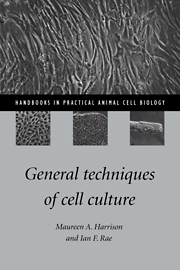5 - Cell culture
Published online by Cambridge University Press: 02 February 2010
Summary
As explained in Chapter 1, one of the advantages of cell culture is that it may be used, in many cases, as an alternative technique to the use of live animals for studying models of physiological function in vivo. It is therefore essential that in vitro conditions mimic as closely as possible those that the cell would encounter in vivo. An exact replica of these conditions cannot be achieved, and consequently there will inevitably be changes in cell characteristics. Cell-to-cell interactions are reduced and cells which would not normally proliferate in vivo will do so under in vitro situations. This eventually leads to the growth of unspecialized cells rather than the expression of differentiated functions, which is why it is important to check cell characteristics regularly when cells have been cultured for any length of time. (Further discussion on this and other related factors will be covered in Chapter 8, Quality Control.)
Primary culture techniques are explained in Chapter 6. Once a primary culture has been maintained for some hours, some cell types will proliferate whilst others will survive but not multiply and others will die off. In this way, in the case of monolayer cultures, the distribution of cell types will alter until the cells are confluent, i.e. the cells are touching each other and there is no more substrate space. At confluence, the culture will have its closest resemblance to the parent tissue. After passage or subculture, the primary culture becomes a cell line (now termed a secondary culture) and may be subcultured several more times (but not necessarily established, after a few passages).
- Type
- Chapter
- Information
- General Techniques of Cell Culture , pp. 69 - 88Publisher: Cambridge University PressPrint publication year: 1997

